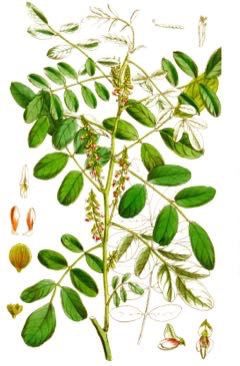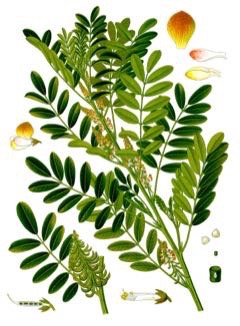 |
|
http://www.edibleplants.org |
 |
| http://www.edibleplants.org |
Translate this page:
Summary
Indigofera suffruticosa,commonly known in various names such as Guatemala indigo, small-leaved indigo, West Indian indigo, wild indigo, anil indigo, and anil de pasto, is a flowering plant growing up to 1 m tall which can be found in South America. it is an erect and branching shrub with pinnate leaves. The rootstock are woody while the stems are often woody but can also be herbaceous. It has been known as 'the king of dyes' due to its fascinating deep blue color. Medicinally, Anil indigo is applied to the bee and other insects stings to reduce pain and inflammation. Root decoction is used against stomach pain. The leaves are used for fever, and scrofula when combined with the bark of Philodendron chinense. Plant juice is used as a treatment for diarrhea.
Physical Characteristics

 Indigofera suffruticosa is an evergreen Perennial growing to 1.5 m (5ft) by 1.5 m (5ft) at a fast rate.
Indigofera suffruticosa is an evergreen Perennial growing to 1.5 m (5ft) by 1.5 m (5ft) at a fast rate.
See above for USDA hardiness. It is hardy to UK zone 10.
It can fix Nitrogen.
Suitable for: light (sandy), medium (loamy) and heavy (clay) soils, prefers well-drained soil and can grow in nutritionally poor soil. Suitable pH: mildly acid and neutral soils and can grow in very acid soils.
It can grow in semi-shade (light woodland) or no shade. It prefers dry or moist soil and can tolerate drought.
UK Hardiness Map
US Hardiness Map
Synonyms
Indigofera anil L.
Plant Habitats
Edible Uses
References More on Edible Uses
Medicinal Uses
Plants For A Future can not take any responsibility for any adverse effects from the use of plants. Always seek advice from a professional before using a plant medicinally.
Antibacterial Antidiarrhoeal Antiinflammatory Diaphoretic Febrifuge Vermifuge
The plant finds some use in domestic medicine in Guatemala. Indigo is often applied to the stings of bees and other insects to reduce pain and inflammation, although its efficacy is somewhat doubtful[331 ]. A decoction of the roots is taken against stomach-ache[310 ]. A tincture of the roots and seeds in rum is used as a vermifuge[310 ]. The leaves are resolutive and sudorific[348 ]. An infusion of bruised leaves is used as a treatment for fever[310 ]. Combined with the leaves of Indigofera tinctoria and the bark of Phellodendron chinense, it is used as a medicine against scrofula[310 ]. The fresh leaves are used in a warm bath to act as a calmative[348 ]. The plant juice is used as a treatment for diarrhoea[310 ].
References More on Medicinal Uses
The Bookshop: Edible Plant Books
Our Latest books on Perennial Plants For Food Forests and Permaculture Gardens in paperback or digital formats.

Edible Tropical Plants
Food Forest Plants for Hotter Conditions: 250+ Plants For Tropical Food Forests & Permaculture Gardens.
More

Edible Temperate Plants
Plants for Your Food Forest: 500 Plants for Temperate Food Forests & Permaculture Gardens.
More

More Books
PFAF have eight books available in paperback and digital formats. Browse the shop for more information.
Shop Now
Other Uses
Dye Green manure
Agroforestry Uses: Grown as a cover crop and green manure in coffee, rubber and tea plantations[310 ]. In South America it is one of the components of natural pastures developing after clearing rain forest[310 ]. A good cover of the plant can increase the nitrogen content of the soil considerably. In Sri Lanka for example, an increase from 3.7% to 5.3% in 4 years was found[310 ]. Other Uses: The plant is a major source of the blue dye indigo[331 ]. Plants contain the glucoside indican, which transforms into indoxyl (indigo-white) and glucose by enzymatic hydrolysis[310 ]. Indoxyl can then be oxidized to the dye indigo-blue[310 ]. It is perhaps just as well for Central America that the cultivation of indigo has largely been abandoned, since preparation of the dye was injurious to the health of persons employed in the industry. The freshly cut plants were immersed in large vats lined with bricks, such as may sometimes be discovered even now about Central American fincas. After fermentation had proceeded for some time, the plants were trampled by men in the tanks, after which the dye settled to the bottom of the water and was formed into small cakes that were later dried[331 ]. Indigo was formerly much planted in some parts of Guatemala, especially in the Oriente and along the Pacific foothills and plains, and some is grown even today, for dyeing native textiles. The indigo-coloured coats and trousers forming the costumes of the men of certain highland towns are most distinctive. As late as 1883 it was reported that 135 quintales (hundredweight) of indigo were exported from Guatemala.
Special Uses
Attracts Wildlife Carbon Farming Coppice Ground Cover Nitrogen Fixer
References More on Other Uses
Cultivation details
Agroforestry Services: Contour hedgerow Agroforestry Services: Nitrogen Industrial Crop: Dye Management: Coppice Minor Global Crop
Succeeds in tropical and subtropical climates. Plants are not frost resistant[375 ]. Well adapted to fertile silty-sandy soils[375 ]. Succeeds in soils with low fertility[375 ]. Grows well in soils with a low pH[375 ]. Established plants are drought resistant[375 ]. This species has a symbiotic relationship with certain soil bacteria, these bacteria form nodules on the roots and fix atmospheric nitrogen. Some of this nitrogen is utilized by the growing plant but some can also be used by other plants growing nearby[755 ]. Flowering Time: Late Winter/Early Spring Mid Spring Mid Winter. Bloom Color: Purple. Spacing: 6-8 ft. (1.8-2.4 m).
Carbon Farming
-
Agroforestry Services: Contour hedgerow
Alley cropping systems on the contour of slopes.
-
Agroforestry Services: Nitrogen
Plants that contribute to nitrogen fixation include the legume family – Fabaceae.
-
Industrial Crop: Dye
Botanical dyes replacing synthetic dyes (known as heavy polluters).
-
Management: Coppice
Cut to the ground repeatedly - resprouting vigorously. Non-destructive management systems maintaining the soil organic carbon.
-
Minor Global Crop
These crops are already grown or traded around the world, but on a smaller scale than the global perennial staple and industrial crops, The annual value of a minor global crop is under $1 billion US. Examples include shea, carob, Brazil nuts and fibers such as ramie and sisal.
References Carbon Farming Information and Carbon Sequestration Information
Temperature Converter
Type a value in the Celsius field to convert the value to Fahrenheit:
Fahrenheit:
The PFAF Bookshop
Plants For A Future have a number of books available in paperback and digital form. Book titles include Edible Plants, Edible Perennials, Edible Trees,Edible Shrubs, Woodland Gardening, and Temperate Food Forest Plants. Our new book is Food Forest Plants For Hotter Conditions (Tropical and Sub-Tropical).
Shop Now
Plant Propagation
Seed - sowing is done either in seed-beds or directly into the field[310 ]. Seed Collecting: Allow pods to dry on plant; break open to collect seeds. Pre-soak the seed in warm water overnight for optimal germination[310 ]. Germination takes 4 - 6 days[310 ]. Seedlings quickly develop a deep root system and so, when a seed-bed is used the seedlings should be transplanted into their permanent positions within 4 - 6 weeks after sowing[310 ]. Stem cuttings are taken from well developed branches divided into 30 cm long pieces[310 ]. They are kept for 2 - 3 days in a cool place before planting out, 2 - 3 per hole. Rooting starts in the second week[310 ].
Other Names
If available other names are mentioned here
anil indigo, mexikanischer Indigostrauch - German, añil - Spanish, västindisk indigo - Swedish.
Native Range
NORTHERN AMERICA: United States (Florida, Louisiana, Mississippi, Texas), Mexico (Sinaloa, Sonora, Tamaulipas, Zacatecas (south), Aguascalientes, Chiapas, Colima, Guerrero, Hidalgo, Jalisco, Michoacán de Ocampo, Nayarit, Oaxaca, Tabasco, Veracruz de Ignacio de la Llave, Yucatán) SOUTHERN AMERICA: Anguilla, Antigua and Barbuda, Bahamas, Barbados, Cuba, Cayman Islands, Dominica, Dominican Republic, Guadeloupe, Grenada, Haiti, Jamaica, St. Lucia, Montserrat, Martinique, United States (Puerto Rico, Virgin Islands, U.S.), St. Vincent and Grenadines, Virgin Islands (British), Belize, Costa Rica, Guatemala, Honduras, Nicaragua, Panama, El Salvador, French Guiana, Guyana, Suriname, Venezuela, Brazil, Bolivia, Colombia, Ecuador, Peru, Argentina (Buenos Aires, Catamarca, Córdoba, Corrientes, Entre Ríos, Jujuy, Misiones, Salta, Tucumán), Paraguay
Weed Potential
Right plant wrong place. We are currently updating this section.
Please note that a plant may be invasive in one area but may not in your area so it's worth checking.
Conservation Status
IUCN Red List of Threatened Plants Status : This taxon has not yet been assessed

Growth: S = slow M = medium F = fast. Soil: L = light (sandy) M = medium H = heavy (clay). pH: A = acid N = neutral B = basic (alkaline). Shade: F = full shade S = semi-shade N = no shade. Moisture: D = dry M = Moist We = wet Wa = water.
Now available:
Food Forest Plants for Mediterranean Conditions
350+ Perennial Plants For Mediterranean and Drier Food Forests and Permaculture Gardens.
[Paperback and eBook]
This is the third in Plants For A Future's series of plant guides for food forests tailored to
specific climate zones. Following volumes on temperate and tropical ecosystems, this book focuses
on species suited to Mediterranean conditions—regions with hot, dry summers and cool, wet winters,
often facing the added challenge of climate change.
Read More
Expert comment
Author
Mill.
Botanical References
1
Links / References
For a list of references used on this page please go here
A special thanks to Ken Fern for some of the information used on this page.
Readers comment
| Add a comment |
|
If you have important information about this plant that may help other users please add a comment or link below. Only comments or links that are felt to be directly relevant to a plant will be included. If you think a comment/link or information contained on this page is inaccurate or misleading we would welcome your feedback at [email protected]. If you have questions about a plant please use the Forum on this website as we do not have the resources to answer questions ourselves.
* Please note: the comments by website users are not necessarily those held by PFAF and may give misleading or inaccurate information.
To leave a comment please Register or login here All comments need to be approved so will not appear immediately.
|
Subject : Indigofera suffruticosa
|
|
|
|